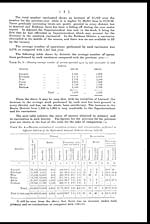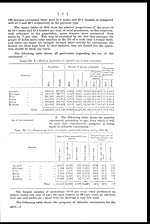Medicine - Vaccination > 1872-1903 - Report on vaccination in the Hyderabad Assigned Districts > Vaccination Hyderabad 1872-1889 > 1881-1882 - Report on vaccination in the Hyderabad Assigned Districts, for the official year 1881-82
(222) Page 4
Download files
Individual page:
Thumbnail gallery: Grid view | List view

( 4 )
In primary vaccination the highest percentage of success, 93.4, was
obtained in the Wun District, and the lowest, 86.7, in Akola. The rate for
the province was 89.8, as compared with 86.7 in the previous year.
The total number of re-vaccinations performed was 111, against 67, and
the percentages of success 63 and 26.9 respectively.
The number of unsuccessful and unknown cases under both heads is
lower than in the previous year.
The standard of success obtained in primary operations in Berar does
not compare favourably with that for other provinces in India, though it is
better than the results obtained last year. The cause of this cannot be
explained other than the difficulty experienced by the vaccinators in carrying
on arm-to-arm vaccination. Mothers object to take their children from
one village to another in order to allow of lymph being taken from the
vessicles on the spot, even though offered batta at the rate of two annas a
mile; consequently the vaccinators have to resort to the use of stored lymph
with the result of a larger number of failures than if liquid lymph from one
arm to another had been used. The persuasive powers of the vaccinators
go a very little way towards overcoming the scruples of the people in this
direction.
Though special attention was paid to the quality of the vaccination in
each circle, and every endeavour made to ensure good results, even at a
sacrifice of numbers, yet the result has been only 89.8 per cent. of success,
as compared with 98 and 96 in Bengal and Bombay respectively. Every
endeavour will, however, it is needless to remark, be made to work up to
these standards.
Vaccination work of Berar compar-
ed with other provinces.
4. The following table compares the vaccination work performed in
Berar with that of other provinces in India.
The figures show the average of the last four
years, and have been compiled from the reports
of the Sanitary Commissioner with the Government of India.
Compared with the neighbouring Central Provinces, it. is curious to
note that, though the average numbers vaccinated by each vaccinator, per-
centage of success attained, and the proportion of the population protected,
are higher than in Berar, yet the death-rate from small-pox is also higher.
TABLE No. 5.— Comparing average vaccination work of Berar for the last fours years with
that of other Presidencies (1877-78 to 1880-81).
|
Province. |
Average num- |
Percentage of |
Percentage of |
Ratio of suc- |
Ratio of |
|
1 |
2 |
3 |
4 |
5 |
6 |
|
Bengal ... ... |
1,424 |
98.57 |
* 7.54 |
† 20.67 |
‡ 2.7 |
|
North West Province & Oudh |
1,149 |
87.86 |
11.16 |
12.79 |
1.68 |
|
Punjab ... ... |
2,598 |
96.04 |
34.61 |
20.92 |
1.59 |
|
British Burma ... ... |
1,026 |
76.64 |
5.34 |
9.67 |
.83 |
|
Madras ... ... |
814 |
86.41 |
4.87 |
16.5 |
1.50 |
|
Bombay ... ... |
1,577 |
95.15 |
32.24 |
24.32 |
.52 |
|
Central Provinces ... |
1,652 |
95.42 |
39.12 |
37.11 |
1.67 |
|
Berar ... ... |
1,368 |
85.3 |
43.52 |
29.1 |
1.41 |
Sex of the vaccinated.
5. Excluding dispensary vaccination, the total number of males vacci-
nated was 45,899, and females 44,270, or an
excess of 1,629 males over females. In every
Note.—* Average of two years only, figures for 1878-79 and 1879-80 not being available.
† Average for three years, figures for 1878-79 not being available.
‡ Figures in column 6 are for the calendar year.
Set display mode to: Large image | Zoom image | Transcription
Images and transcriptions on this page, including medium image downloads, may be used under the Creative Commons Attribution 4.0 International Licence unless otherwise stated. ![]()
| Permanent URL | https://digital.nls.uk/91172108 |
|---|
| Attribution and copyright: |
|
|---|




